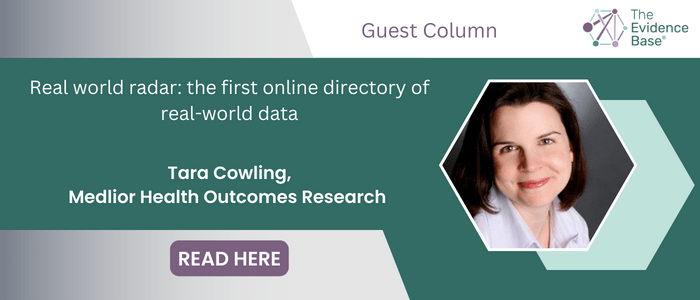Real World Radar: the first online directory of real-world data

Real-world evidence (RWE) is a rapidly evolving field, with increasing availability and quality of real-world data (RWD) sources. To maximize the potential of RWE for drug development, patient care, and public health, researchers must be able to access the most relevant RWD to meet their research goals. Real World Radar (RWR) is a subscription-based digital directory of RWD that can simplify and expedite RWE research. The online platform, developed by Medlior Health Outcomes Research in 2018, allows subscribers to quickly identify relevant sources of RWD and PubMed citations associated with each dataset.
RWD includes any patient-level data sources that are not part of a controlled clinical trial, such as registries, cohort studies, surveys, commercial claims, administrative databases, etc. With over 2200 datasets from more than 36 jurisdictions (e.g., 440 datasets from the US, 191 from Denmark, 186 from the UK, 52 from Australia), and new datasets being added continuously, RWR is the first of its kind for RWE generation. Finding RWD via PubMed or Google search is not easy; researchers can save time using RWR, where datasets for an indication of interest can be found in seconds.
The short video below shows how RWR works:
The key benefits of RWR include:
- Reducing the redundancy of research (by identifying if datasets already exist)
- Increasing collaboration (by identifying other research groups)
- Increasing funding for new RWD sources (by identifying an unmet need for data collection)
- Monitoring the new RWD added to the site each month
- Conducting feasibility assessments for generating RWE
RWR in context
There are many key factors to consider when assessing the feasibility of leveraging different RWD sources. Information on these factors can be found with RWR through hyperlinks to dataset landing pages and, if available, PubMed citations of studies that have already utilized the datasets. Some of the key factors for leveraging RWD include:
- Access to data: Some RWD sources may be readily available to researchers, while others may require collaboration with healthcare institutions, data providers, or government agencies.
- Data privacy and ethics: RWD often involves sensitive patient information. Data privacy and ethical considerations should be considered when accessing and using RWD sources, as there may be legal and ethical constraints in place.
- Data quality: Data may be messy, incomplete, or inconsistent. Data quality issues can affect the reliability of research findings.
- Data diversity: The availability of diverse data sources is important for conducting robust RWE studies. Data may be required from different healthcare settings and populations to address specific research questions.
- Research purpose: The ease of finding RWD sources can also depend on the research goals. Some sources may be suitable for certain types of studies but less so for others.
- Collaboration: Collaborating with healthcare institutions, research organizations, or data providers can facilitate access to RWD sources. Establishing partnerships can be helpful.
- Regulation and compliance: In some regions, there are regulations that govern the use of healthcare data, and compliance with these regulations is essential.
- Data analysis and integration: Working with RWD may require data analysis and integration skills, as RWD sources may not be available in a standardized format. Pre-processing and cleaning the data may be required before analysis.
How to use RWR
RWR is an online portal that can be accessed by subscribers to understand which datasets are capturing patient-level data in a therapeutic area of interest. By going to the hyperlink landing page for the dataset, researchers can contact the data owners to learn more about gaining access and collaboration opportunities. In addition, subscribers can utilize the PubMed functionality to see what citations are associated with their datasets; this feature helps users gauge the validity of a data source and understand its feasibility for addressing their specific research objectives.
Alternatively, Medlior has conducted projects for industry clients using RWR as the primary tool for identifying RWD. These projects, known as ‘database mapping,’ identify and extract publicly available information on RWD sources. Medlior also conducts supplementary, targeted peer-review and grey literature searches to identify additional datasets not captured on RWR. At the end of the project, Medlior adds any new datasets identified through the supplementary search to RWR for PubMed integration and online viewing by subscribers.
What happens after RWR?
An optional step following database mapping is a systematic quality appraisal. For industry-sponsored projects at Medlior, team members apply an in-house quality rating system to each dataset to assess the feasibility for linkage to other sources of RWD, availability for industry-sponsored research, timelines and costs of requesting data, and data quality measures (i.e., evidence of validation). Databases receive one star for each of these components, based on publicly available information, and the number of stars is used to rank the suitability of datasets for industry research.
Subsequently, an in-depth feasibility assessment project can be initiated for the datasets ranked as the most relevant and accessible. The feasibility assessment moves beyond publicly available information from the database mapping results into direct contact with data custodians to discuss whether their data is available and suitable to address research questions of interest. Additionally, these projects utilize RWR to identify PubMed citations to develop an algorithm for identifying the patient population of interest and define variables of interest.
Finally, an RWE study protocol can be developed to address the research objectives. The pathway from mapping to feasibility to study execution ensures the highest quality RWE is generated with the most suitable RWD available.
In cases where the database mapping does not identify relevant datasets, or the feasibility assessment finds the data captured is not accessible or reliable, prospective data collection may be required.
The online first directory of real-world datasets
RWR is a valuable tool for anyone working in RWE to inform and improve RWE strategies. By reducing redundancy in research and increasing collaborations, RWR helps subscribers understand what RWD is available and feasible to address RWE objectives across a breadth of therapeutic areas.
 Author
Author
Tara Cowling, Founder and President
Tara founded Medlior Health Outcomes Research Ltd. in 2008 with a vision for pioneering the future of healthcare with data driven solutions. Tara has over 20 years of health outcomes research experience in both public sector and industry. Including roles with Alberta Health Services, AstraZeneca, IQVIA, and the National Institute for Health and Care Excellence (NICE) in the UK.
The Medlior team rigorously conducts health outcomes research leading to high-quality evidence to inform decision-making.
For more information on RWR or to set-up a live demo, contact Medlior on [email protected].
Sponsorship for this Guest Column was provided by Medlior Health Outcomes Research.







